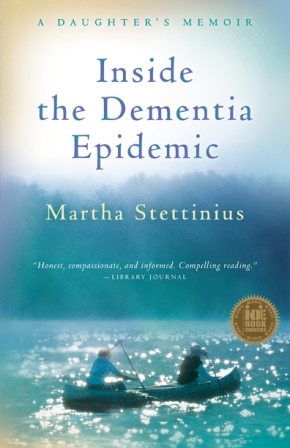Statistics and Facts
About Alzheimer's Disease and Other Dementias:
- Check out this excellent infographic: "The Dementia Epidemic"
- Watch this 2-min video on "Alzheimer's Disease Facts and Figures 2014" from the Alzheimer's Association
- One in 3 seniors will die with Alzheimer's disease or another dementia
- “Dementia” is an umbrella term describing a variety
of diseases and conditions that develop when nerve
cells in the brain die or no longer function normally.
The death or malfunction of these nerve cells, called
neurons, causes changes in one’s memory, behavior
and ability to think clearly. In Alzheimer’s disease,
these brain changes eventually impair an individual’s
ability to carry out such basic bodily functions as
walking and swallowing. Alzheimer’s disease is
ultimately fatal.
(source: Alzheimer's Association. “2012 Alzheimer's
Disease Facts and Figures.” Alzheimer's and Dementia:
The Journal of the Alzheimer's Association. March 2012;
8:131–168)
- One in 8 people over age 65 in the United States has Alzheimer’s disease, and nearly 50% over age 85.
- In 2014, an estimated 5.2 million people in the United States are living with Alzheimer’s disease.
- Women are more likely to develop Alzheimer's disease. A woman age 65 or older has a 1 in 6 chance of developing Alzheimer's disease in her lifetime, compared to 1 in 11 for a man.
- Longer life expectancies and aging baby boomers will increase the numbers and percentages of Americans who will be among the oldest-old. Between 2010 and 2050, the oldest-old are expected to increase from 15 percent of all older people in the United States to one in every four older Americans (24 percent). This will result in an additional 15 million oldest-old people —individuals at high risk for developing Alzheimer’s. (source: Alzheimer's Association. “2012 Alzheimer's disease facts and figures.” Alzheimer's and Dementia: The Journal of the Alzheimer's Association. March 2012; 8:131–168)
- Alzheimer’s disease is the fifth-leading cause of death in the United States for those age 65 and older, but the only one in the top ten without a means of prevention, a way to slow its progression, or a cure.
- The 35.6 million with dementia worldwide in 2010 is expected to double by 2030 to 65.7 million, and then nearly double again by 2050 to 115.4 million.
- Alzheimer’s disease is the most common form of dementia, at 60-80%, but there are over 100 types of dementia, including vascular dementia from small strokes, which accounts for up to 20% of dementias, dementia from Parkinson’s disease, Frontotemporal dementia, and “Familial Alzheimer’s disease” (also called “early-onset” Alzheimer’s disease), which occurs before the age of 60 and represents 5-7% of Alzheimer’s cases. “Mixed dementia”—Alzheimer’s plus another type of dementia—has been shown in autopsies to occur in up to 45 percent of people with dementia.
- In the United States in 2012, Medicare, Medicaid and out-of-pocket expenditures for Alzheimer’s and other dementia care total $200 billion. By 2050, the projected cost will reach $1.1 trillion.
- No medication exists to slow the progression of Alzheimer’s disease, but two types of prescription medications have been approved by the FDA to lessen the symptoms for up to 3 years: cholinesterase inhibitors (Aricept, Exelon, and Razadyne), and Namenda, an N-methyl D-aspartate antagonist.
- Most scientists agree that there are certain risk factors for Alzheimer’s disease. They include old age; a family history; serious head trauma; poor cardiovascular health; high blood pressure; stroke; diabetes; high cholesterol; obesity in middle age; a low education level (which predisposes someone to less learning and brain development over their lifetime); and smoking.
- Some researchers say that exercise may be our most powerful antidote for Alzheimer’s disease. Research shows that daily activity of all kinds—from formal exercise to activities such as washing dishes, cleaning, and cooking—may reduce the risk of developing Alzheimer’s disease, even in people over age 80. Other studies show that people who walk for 40 minutes a day for a year regain volume in their hippocampus, reversing brain shrinkage, and that people with mild cognitive decline who do resistance weight training 2 times a week for 6 months show an increase in their memory and executive function (the ability to multi-task).
- No test exists that will confirm a diagnosis of Alzheimer’s disease, but doctors can diagnose “probable Alzheimer’s disease” with 90% accuracy with neuropsychological testing and by ruling out other causes of memory problems and cognitive decline. A medical history can rule out depression; lab work can rule out urinary infection, thyroid dysfunction, and vitamin deficiencies; and a CT scan and MRI can rule out strokes, trauma, and tumors.
- Other risk factors for Alzheimer’s disease include: undiagnosed or untreated vision problems (a 9.5-fold increase in risk); sleep apnea (doubles your risk); and insulin resistance or pre-diabetes (which makes you 70% more likely than someone with normal blood sugar and insulin levels to develop Alzheimer’s disease).
- More than 18 million American adults have sleep apnea, a risk factor for Alzheimer’s disease. Sleep apnea is as common as Type-II diabetes.
- Many researchers now describe Alzheimer’s disease as “Type III diabetes”—diabetes of the brain.
- People with Type II diabetes are twice as likely to develop Alzheimer’s disease as those without diabetes. Diabetics on insulin therapy are 4 times as likely than non-diabetics to develop Alzheimer’s disease. Twenty million people in the U.S. have Type II diabetes, and twice that number are insulin resistant and pre-diabetic.
- Benefits of early diagnosis of Alzheimer’s disease (paraphrased from the Alzheimer’s Association’s 2011 report “Alzheimer’s Disease Facts and Figures”):
- The cognitive decline may be caused by
something treatable, such as depression
or a vitamin B12 deficiency, and early
diagnosis prevents further decline;
- It’s important to discuss the diagnosis with family
members and begin the search for appropriate
support services;
- Such a discussion reduces anxiety by naming the
problem;
- Medication and other approaches may be used to
manage symptoms;
- Early diagnosis gives people the option of joining
clinical trials;
- It allows more awareness of how some
combinations of medications make
symptoms worse;
- It alerts doctors and family members to the
possibility that the person may need assistance
with daily tasks such as cooking and managing
medications;
- It may reduce falls and other accidents because
caregivers are more aware of the dangers;
- It allows an awareness of financial problems
such as the person giving money to scams; and
- It allows the person with dementia and their
family members to plan for the future.
- In 2011, the federal government allotted $450 million for Alzheimer’s research through the National Institutes of Health, compared to over $3 billion for HIV/AIDS, over $4 billion for heart and cardiovascular disease, and nearly $6 billion for cancer. In February 2012 the Obama administration announced an increase in the federal budget for Alzheimer’s research of $130 million, bringing the total to $580 million.
- Sixty-four percent of people aged 65 or older in nursing homes have Alzheimer’s disease or another dementia



















Reader Comments